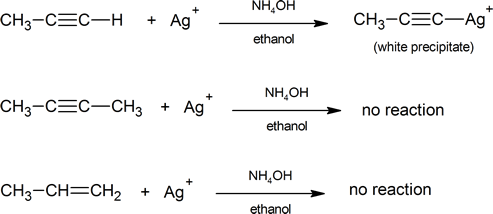Objectives
After completing this section, you should be able to
- write an equation for the reaction that occurs between a terminal alkyne and a strong base, such as sodamide, NaNH2.
- rank a given list of compounds, including water, acetylene and ammonia, in order of increasing or decreasing acidity.
- rank a given list of hydrocarbons, such as acetylene, ethylene and ethane, in order of increasing or decreasing acidity.
- describe a general method for determining which of two given compounds is the stronger acid.
- provide an acceptable explanation of why terminal alkynes are more acidic than alkanes or alkenes.
Key Terms
Make certain that you can define, and use in context, the key terms below.
- acetylide anion
- acidity order
Study Notes
An acetylide anion is an anion formed by removing the proton from the end carbon of a terminal alkyne:

An acidity orderis a list of compounds arranged in order of increasing or decreasing acidity.
The general ideas discussed in this section should already be familiar to you from your previous exposure to chemistry and from the review in Section 2.8. A slightly different account of why terminal alkynes are stronger acids than are alkenes or alkanes is given below. However, the argument is still based on the differences between sp-, sp2– and sp3-hybrid orbitals.
The carbons of a triple bond are sp-hybridized. An sp‑hybrid orbital has a 50% s character and a 50% p character, whereas an sp2‑hybrid orbital is 33% s and 67% p, and an sp3‑hybrid orbital is 25% s and 75% p. The greater the s character of the orbital, the closer the electrons are to the nucleus. Thus in a C(sp)$\ce{-}$H bond, the bonding electrons are closer to the carbon nucleus than they are in a C(sp2)$\ce{-}$H bond. In other words, compared to a C(sp2)$\ce{-}$H bond (or a C(sp3)$\ce{-}$H bond), a C(sp)$\ce{-}$H bond is very slightly polar: Cδ−$\ce{-}$Hδ+. This slight polarity makes it easier for a base to remove a proton from a terminal alkyne than from a less polar or non-polar alkene or alkane.
As you will appreciate, the reaction between sodium amide and a terminal alkyne is an acid-base reaction. The sodium acetylide product is, of course, a salt. Terminal alkynes can also form salts with certain heavy-metal cations, notably silver(I) and copper(I). In the laboratory component of this course, you will use the formation of an insoluble silver acetylide as a method for distinguishing terminal alkynes from alkenes and non-terminal alkynes:

Metal acetylides are explosive when dry. They should be destroyed while still wet by warming with dilute nitric acid:

Acidity of Terminal Alkynes: Formation of Acetylide Anions
Terminal alkynes are much more acidic than most other hydrocarbons. Removal of the proton leads to the formation of an acetylide anion, RC=C:–. The origin of the enhanced acidity can be attributed to the stability of the acetylide anion, which has the unpaired electrons in an sp hybridized orbital. The stability results from occupying an orbital with a high degree of s-orbital character. There is a strong correlation between s-character in the orbital containing the non-bonding electrons in the anion and the acidity of hydrocarbons. The enhanced acidity with greater s-character occurs despite the fact that the homolytic C-H BDE is larger.
| Compound | Conjugate Base | Hybridization | “s Character” | pKa | C-H BDE (kJ/mol) |
| CH3CH3 | CH3CH2– | sp3 | 25% | 50 | 410 |
| CH2CH2 | CH2CH– | sp2 | 33% | 44 | 473 |
| HCCH | HCC– | sp | 50% | 25 | 523 |
Consequently, acetylide anions can be readily formed by deprotonation using a sufficiently strong base. Amide anion (NH2–), in the form of NaNH2 is commonly used for the formation of acetylide anions.


Exercises
- Given that the pKa of water is 15.74, would you expect hydroxide ion to be capable of removing a proton from each of the substances listed below? Justify your answers, briefly.
- ethanol (pKa = 16)
- acetic acid (pKa = 4.72)
- acetylene (pKa = 25)
Answers
1.
Question
If KOH has a pKa of 15.7 in water, what pKa be required to deprotonate KOH?
Solutions
1.
Contributors
- Dr. Dietmar Kennepohl FCIC (Professor of Chemistry, Athabasca University)
- Prof. Steven Farmer (Sonoma State University)
- William Reusch, Professor Emeritus (Michigan State U.), Virtual Textbook of Organic Chemistry